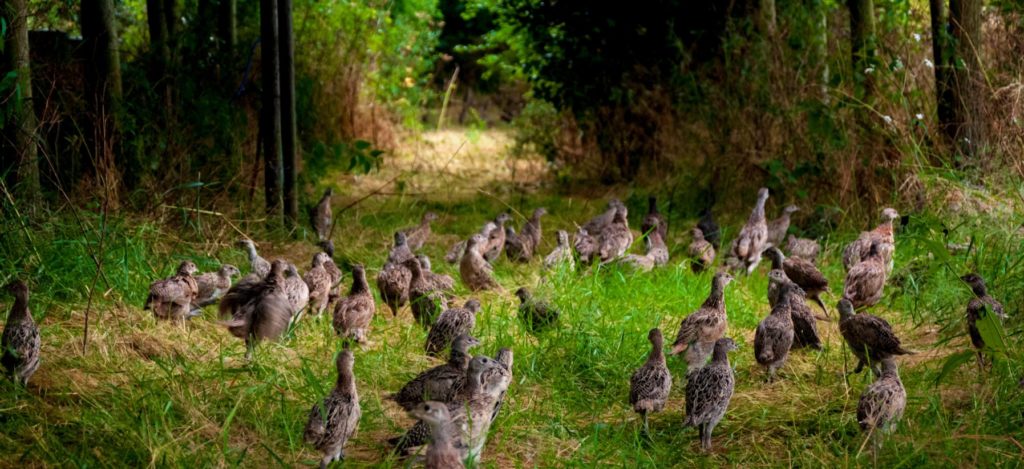Wild Justice challenges gamebird releases

Last week Wild Justice sent a Pre Action Protocol letter to Michael Gove at Defra requiring him to assess the impacts of the release of the vast and increasing numbers of non-native gamebirds into the countryside. This, we argue, is a legal requirement under the EU Habitats Directive. Please support our crowdfunder.
Every year 43 million captive-reared Pheasants (and 9 million Red-legged Partridges) are released into the countryside. The numbers released have increased about 10-fold in the last 45 years and, like most of the rest of the shooting industry’s activities, are not regulated by government. More paperwork is needed to reintroduce native UK species into the countryside for conservation purposes than to release non-native omnivorous birds on a vast scale to fuel recreational shooting.
Gamebird releases and associated shooting are of concern because:
- Pheasants and Red-legged Partridges eat a wide variety of native plants, invertebrates, reptiles and even small birds and mammals. These impacts must be properly assessed particularly since release numbers are unregulated and increasing.
- One in three released gamebirds are shot for recreation but the rest die of disease, on the roads, from starvation or are killed by predators. This bonanza of prey and carrion feeds the numbers of a range of generalist predators and scavengers. High UK populations of Red Foxes and Carrion Crows may affect the numbers of some ground-nesting birds such as Curlew and Lapwing.
- Gamebirds can carry diseases that affect native wildlife, commercial poultry stocks and people. Pheasants often have high burdens of the ticks which transmit Lyme disease to humans.
- Pheasants are shot with lead ammunition, the vast majority of which is discharged into the countryside and accumulates. Lead is a poison for wildlife and people.
- The illegal persecution of birds of prey continues at a high level in the UK and over 60% of those convicted of offences are gamekeepers – most of whom will be employed by shooting estates which release Pheasants and Red-legged Partridges.
- Pheasant numbers are increasing most rapidly in upland areas where their impacts on heathland wildlife through direct predation (eg of Adders and Common Lizards), through their droppings and browsing affecting sensitive plant communities and through altering predator numbers are of growing concern.
- Gamebirds on country roads cause serious road traffic accidents each year.
- Increasingly, shot gamebirds are being dumped or buried in the countryside because the market for food consumption is saturated but the market for recreational shooting is booming.
- Although the shooting industry claims that management for gamebirds benefits other species there is increasing evidence that they are actually a problem for farmland birds because they compete with them for food resources in winter.
- The density of released Pheasants in woodlands is often 10-times that recommended to safeguard invertebrate populations.
- There are very real welfare concerns around the breeding, transport and release of gamebirds including in regard to their importation in their millions from European breeders.
For all these reasons, and probably many others, we believe that gamebird releases ought to be regulated. The Habitats Directive requires the UK to assess ‘plans or projects’ which may affect protected sites of nature conservation importance. There is no doubt in Wild Justice’s mind that the release of 50+ million non-native gamebirds into the countryside is a plan or project which has ecological impacts and which must be assessed.
Please support our crowdfunder so that we can take this case through the courts and compel Defra to act.
Chris Packham, a director of Wild Justice, said ‘The UK’s shooting industry is one of the least regulated in Europe with no centralised collection of any data. No one knows how many birds are released or shot, whether wild or captive bred. So how on earth can that shooting industry claim to be making informed decisions about sustainable harvesting, stocking or conservation? What is blindingly obvious to anyone with even a basic understanding of natural sciences is that dumping at least 50 million non-native birds into the UK countryside will have a profound effect on its ecology – it’s about time we measured what that effect is.‘.
Ruth Tingay, a director of Wild Justice, said ‘It’s worth noting that the 50+ million figure is only a guesstimate, made by the shooting industry six years ago. For all we know there could be 100 million Pheasants and Red-legged Partridges being let loose in the countryside every year. The fact that the Government doesn’t know or care how many are released, and its previous refusal to assess the extent of the environmental damage caused, will come as no surprise to conservationists who have watched this Government put vested interests ahead of wildlife conservation time and time and time again.‘.
Mark Avery, a director of Wild Justice, said ‘Let’s take a step back: if we had never seen a Pheasant or Red-legged Partridge in the countryside and someone suggested releasing over 50 million of these omnivorous non-native gamebirds annually would we just nod it through with no concerns? No! It’s only because this situation has crept up on us through lack of regulatory control that we are in this position. Government has been lax and now Michael Gove must act.‘.
Carol Day, solicitor at Leigh Day, said ‘The aim of the law is to ensure that plans and projects that could have a significant adverse effect on important wildlife sites are properly evaluated before permission is given to carry them out. Our client is arguing that the scale of gamebird releases and the potential impact on the UK’s most important wildlife sites is such that a process for assessment must now be provided.’.
